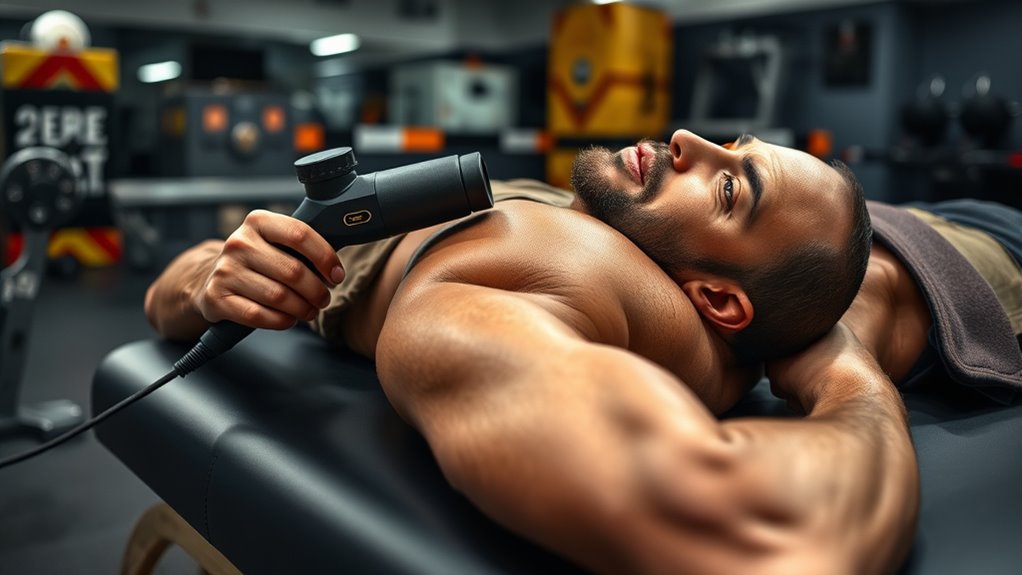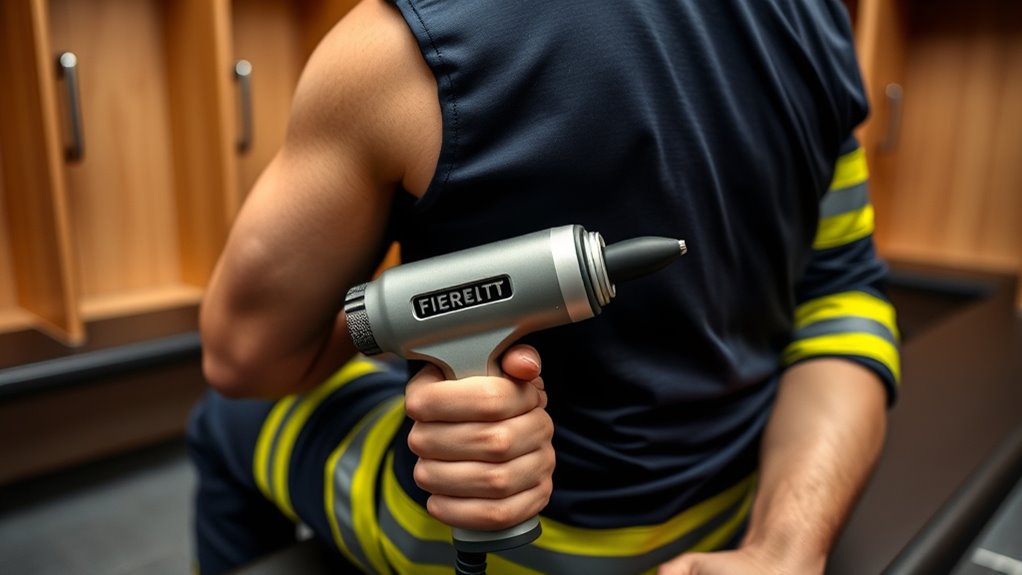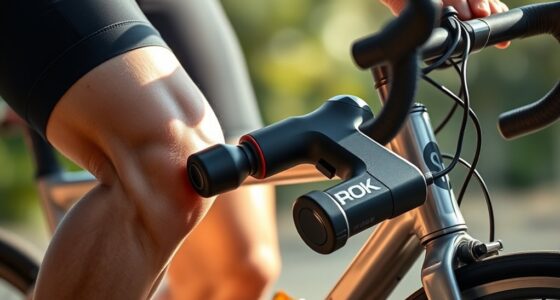After a demanding shift, a massage gun can be your best friend for quick muscle relief. It targets tight areas like shoulders, back, and legs with rapid pulses that boost circulation, break down lactic acid, and ease soreness. Using a massage gun regularly helps prevent injuries and keeps your muscles flexible. To discover how to optimize your recovery routine and stay ready for the next call, keep exploring the benefits.
Key Takeaways
- Massage guns effectively target and loosen tight muscles in shoulders, back, and legs after demanding shifts.
- They improve blood circulation, helping to reduce soreness and accelerate muscle recovery for firefighters.
- Adjustable settings allow personalized treatment, making muscle relief quick and convenient post-shift.
- Regular use can prevent chronic tightness and lower injury risk, supporting long-term muscle health.
- Incorporating massage guns into recovery routines maintains physical readiness and enhances overall firefighter performance.

Firefighters face intense physical demands every day, and muscle fatigue can quickly set in after long shifts or strenuous rescues. When your body is pushed to its limits, it’s vital to find effective recovery techniques to prevent injuries and maintain peak performance. Using a massage gun is one of the most efficient muscle recovery strategies available today. These devices deliver rapid, targeted pulses that help loosen tight muscles, improve circulation, and reduce soreness. After a demanding shift, you might notice tightness in your shoulders, back, or legs—areas that take the brunt of physical exertion. A massage gun can be your go-to solution to alleviate this stress quickly and effectively.
Firefighters face daily physical stress; massage guns help loosen muscles, improve circulation, and speed recovery after tough shifts.
Once you finish a tough day, applying a massage gun helps break down lactic acid buildup in your muscles, which often causes soreness and stiffness. This accelerates your recovery process, so you’re ready for the next call faster. The deep tissue massage provided by these devices stimulates blood flow, bringing fresh oxygen and nutrients to fatigued muscles while flushing out waste products. This not only eases pain but also promotes healing, reducing the risk of future injuries. Regular use of a massage gun can become an integral part of your muscle recovery strategies, helping you bounce back faster and stay resilient.
Using a massage gun is simple and convenient. You can target specific muscle groups that feel tight or tender, adjusting the intensity and speed to suit your needs. Many models come with different attachments designed for various muscle sizes and types. This customization allows you to tailor your recovery routine to where you need it most. Incorporating these devices into your post-shift routine doesn’t require a lot of time—just a few minutes can make a significant difference. It’s an effective way to combat the physical toll of firefighting, helping you feel less sore and more energized.
Moreover, integrating massage guns into your recovery routine supports long-term muscle health. Consistent use can prevent chronic tightness, improve flexibility, and reduce the likelihood of injuries. As a firefighter, your body is your most valuable asset, and taking care of it with proper recovery techniques ensures you’re prepared for whatever challenges lie ahead. When you combine massage gun therapy with other recovery strategies like stretching, hydration, and rest, you create a thorough approach to maintaining peak physical condition. Additionally, diversifying your recovery methods can enhance overall effectiveness and prevent burnout. Ultimately, these tools help you recover faster, stay strong, and perform your best every day.
Frequently Asked Questions
Are Massage Guns Suitable for All Muscle Types?
Massage guns are generally suitable for most muscle types, but you should consider muscle fiber and tissue compatibility. They work well on larger, more flexible muscles, but may be less effective on dense or sensitive tissue. Your muscles’ fiber composition influences how well the device penetrates and relaxes them. Always start with a lower intensity to gauge comfort and effectiveness, ensuring safe use across different muscle types.
How Long Should a Firefighter Use a Massage Gun per Session?
Imagine your muscles as a busy highway needing smooth traffic flow. Use a massage gun for about 1-2 minutes per muscle group, focusing on tight spots. This helps promote muscle recovery and prevents injuries. Don’t overdo it—too much can cause fatigue. Keep your sessions brief but effective, ensuring your muscles stay alert and ready for the next call, like a well-oiled machine in top condition.
Can Massage Guns Replace Professional Physiotherapy?
You might wonder if massage guns can replace professional physiotherapy. While they’re great for muscle recovery and providing quick relief, massage therapy involves tailored techniques that target underlying issues. Massage guns can complement physiotherapy but shouldn’t replace it. For serious injuries or chronic pain, always consult a professional. Using a massage gun regularly can help maintain muscle health, but it’s best to seek expert guidance for thorough treatment.
Are There Any Safety Concerns With Frequent Use?
Imagine you use a massage gun daily after your shift, but overuse risks like skin irritation or muscle bruising could happen. Frequent use might lead to tissue damage or soreness if you don’t follow proper guidelines. Always pay attention to your body’s signals, avoid excessive pressure, and limit use duration. These safety concerns highlight the importance of moderation to prevent overuse risks and skin irritation.
What Features Should Firefighters Look for in a Massage Gun?
When choosing a massage gun, you should focus on features like deep tissue capabilities to target stubborn muscle knots and guarantee effective relief. Portability is also key, so look for a lightweight, compact design that’s easy to carry after a shift. Good battery life is essential for extended use, and adjustable speeds let you customize the massage intensity. These features help you recover faster and stay ready for the next call.
Conclusion
In the end, taking care of your muscles is essential for staying strong on the job. Massage guns offer quick, effective relief after a demanding shift, helping you recover faster and reduce injury risk. Remember, “A stitch in time saves nine”—investing in your muscle health now pays off later. So, don’t wait until pain slows you down; give yourself the care you deserve and keep firefighting at your best.









